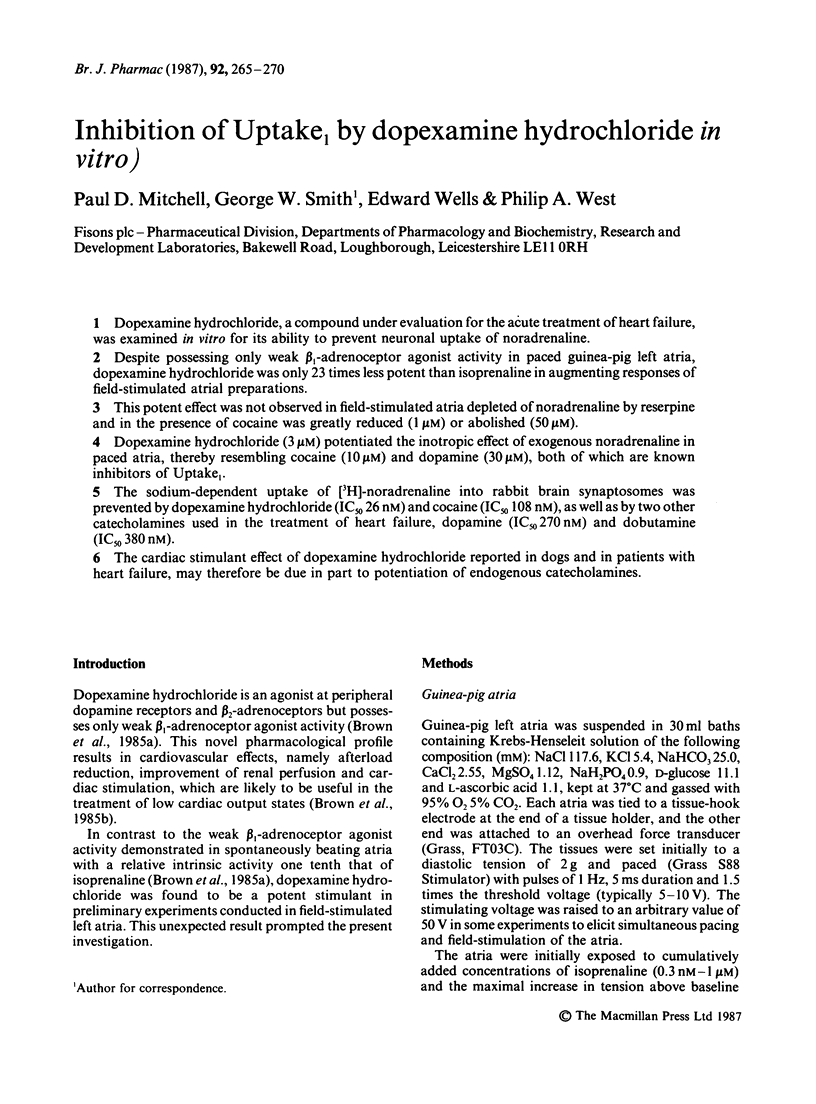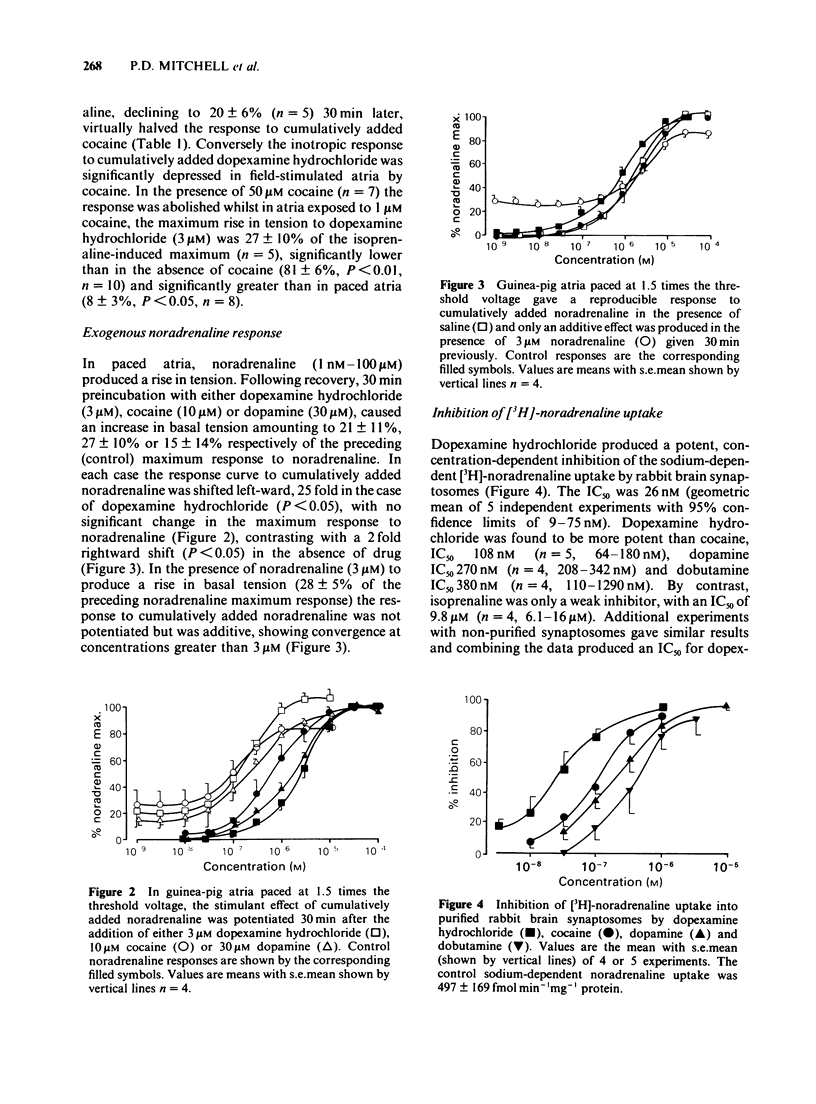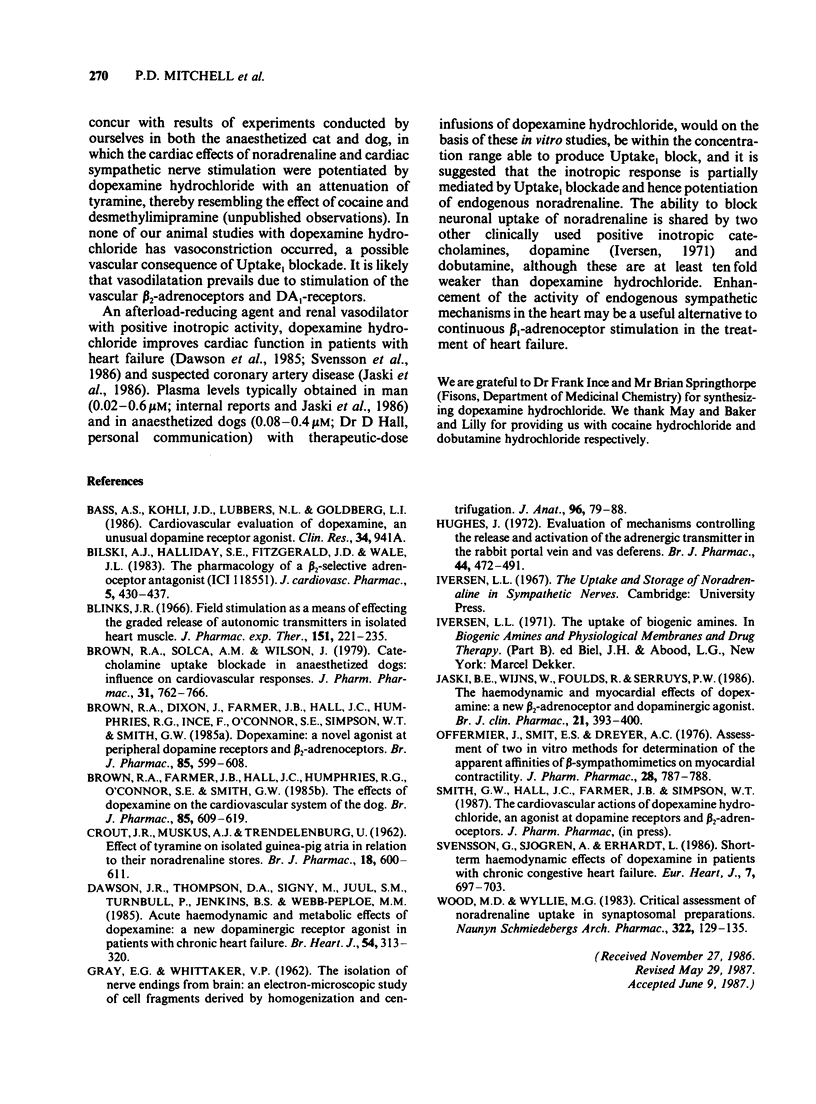Abstract
1 Dopexamine hydrochloride, a compound under evaluation for the acute treatment of heart failure, was examined in vitro for its ability to prevent neuronal uptake of noradrenaline. 2 Despite possessing only weak beta 1-adrenoceptor agonist activity in paced guinea-pig left atria, dopexamine hydrochloride was only 23 times less potent than isoprenaline in augmenting responses of field-stimulated atrial preparations. 3 This potent effect was not observed in field-stimulated atria depleted of noradrenaline by reserpine and in the presence of cocaine was greatly reduced (1 microM) or abolished (50 microM). 4 Dopexamine hydrochloride (3 microM) potentiated the inotropic effect of exogenous noradrenaline in paced atria, thereby resembling cocaine (10 microM) and dopamine (30 microM), both of which are known inhibitors of Uptake. 5 The sodium-dependent uptake of [3H]-noradrenaline into rabbit brain synaptosomes was prevented by dopexamine hydrochloride (IC50 26 nM) and cocaine (IC50 108 nM), as well as by two other catecholamines used in the treatment of heart failure, dopamine (IC50 270 nM) and dobutamine (IC50 380 nM). 6 The cardiac stimulant effect of dopexamine hydrochloride reported in dogs and in patients with heart failure, may therefore be due in part to potentiation of endogenous catecholamines.
Full text
PDF





Selected References
These references are in PubMed. This may not be the complete list of references from this article.
- Bilski A. J., Halliday S. E., Fitzgerald J. D., Wale J. L. The pharmacology of a beta 2-selective adrenoceptor antagonist (ICI 118,551). J Cardiovasc Pharmacol. 1983 May-Jun;5(3):430–437. doi: 10.1097/00005344-198305000-00013. [DOI] [PubMed] [Google Scholar]
- Blinks J. R. Field stimulation as a means of effecting the graded release of autonomic transmitters in isolated heart muscle. J Pharmacol Exp Ther. 1966 Feb;151(2):221–235. [PubMed] [Google Scholar]
- Brown R. A., Dixon J., Farmer J. B., Hall J. C., Humphries R. G., Ince F., O'Connor S. E., Simpson W. T., Smith G. W. Dopexamine: a novel agonist at peripheral dopamine receptors and beta 2-adrenoceptors. Br J Pharmacol. 1985 Jul;85(3):599–608. doi: 10.1111/j.1476-5381.1985.tb10554.x. [DOI] [PMC free article] [PubMed] [Google Scholar]
- Brown R. A., Farmer J. B., Hall J. C., Humphries R. G., O'Connor S. E., Smith G. W. The effects of dopexamine on the cardiovascular system of the dog. Br J Pharmacol. 1985 Jul;85(3):609–619. doi: 10.1111/j.1476-5381.1985.tb10555.x. [DOI] [PMC free article] [PubMed] [Google Scholar]
- Brown R. A., Solca A. M., Wilson J. Catecholamine uptake blockade in anaesthetized dogs: influence on cardiovascular responses. J Pharm Pharmacol. 1979 Nov;31(11):761–766. doi: 10.1111/j.2042-7158.1979.tb13653.x. [DOI] [PubMed] [Google Scholar]
- CROUT J. R., MUSKUS A. J., TRENDELENBURG U. Effect of tyramine on isolated guinea-pig atria in relation to their noradrenaline stores. Br J Pharmacol Chemother. 1962 Jun;18:600–611. doi: 10.1111/j.1476-5381.1962.tb01179.x. [DOI] [PMC free article] [PubMed] [Google Scholar]
- Dawson J. R., Thompson D. S., Signy M., Juul S. M., Turnbull P., Jenkins B. S., Webb-Peploe M. M. Acute haemodynamic and metabolic effects of dopexamine, a new dopaminergic receptor agonist, in patients with chronic heart failure. Br Heart J. 1985 Sep;54(3):313–320. doi: 10.1136/hrt.54.3.313. [DOI] [PMC free article] [PubMed] [Google Scholar]
- GRAY E. G., WHITTAKER V. P. The isolation of nerve endings from brain: an electron-microscopic study of cell fragments derived by homogenization and centrifugation. J Anat. 1962 Jan;96:79–88. [PMC free article] [PubMed] [Google Scholar]
- Hughes J. Evaluation of mechanisms controlling the release and inactivation of the adrenergic transmitter in the rabbit portal vein and vas deferens. Br J Pharmacol. 1972 Mar;44(3):472–491. doi: 10.1111/j.1476-5381.1972.tb07285.x. [DOI] [PMC free article] [PubMed] [Google Scholar]
- Jaski B. E., Wijns W., Foulds R., Serruys P. W. The haemodynamic and myocardial effects of dopexamine: a new beta 2-adrenoceptor and dopaminergic agonist. Br J Clin Pharmacol. 1986 Apr;21(4):393–400. doi: 10.1111/j.1365-2125.1986.tb05213.x. [DOI] [PMC free article] [PubMed] [Google Scholar]
- Offermeier J., Smit E. S., Dreyer A. C. Assessment of two in vitro methods for determination of the apparent affinities of beta-sympathomimetics on myocardial contractility. J Pharm Pharmacol. 1976 Oct;28(10):787–788. doi: 10.1111/j.2042-7158.1976.tb04053.x. [DOI] [PubMed] [Google Scholar]
- Svensson G., Sjögren A., Erhardt L. Short-term haemodynamic effects of dopexamine in patients with chronic congestive heart failure. Eur Heart J. 1986 Aug;7(8):697–703. doi: 10.1093/oxfordjournals.eurheartj.a062125. [DOI] [PubMed] [Google Scholar]
- Wood M. D., Wyllie M. G. Critical assessment of noradrenaline uptake in synaptosomal preparations. Naunyn Schmiedebergs Arch Pharmacol. 1983 Mar;322(2):129–135. doi: 10.1007/BF00512385. [DOI] [PubMed] [Google Scholar]


